5 Tips for Building (Effective) SEO Keyword Lists

Hand off the toughest tasks in SEO, PPC, and content without compromising quality
Explore ServicesSEO keyword lists are the foundations of a solid SEO strategy.
When you do keyword research properly, you focus your goals and drive toward keywords that are going to move the needle for your business.
If you don’t have a plan, you plan to fail.
You won’t be able to target the most profitable keywords, you may miss out on quick wins and you can be leaving valuable rankings on the table.
In this guide, you’re going to learn five simple tips that will help you develop lists of actionable keyword research.
To begin, let’s look at what it means to build a keyword list.
What is an SEO keyword list?
Your SEO keyword list is just a list of the key terms that you’re focusing on for any given project.
There isn’t a specific format that keyword lists need to follow. You can easily create one with a spreadsheet. And it will probably look something like this:
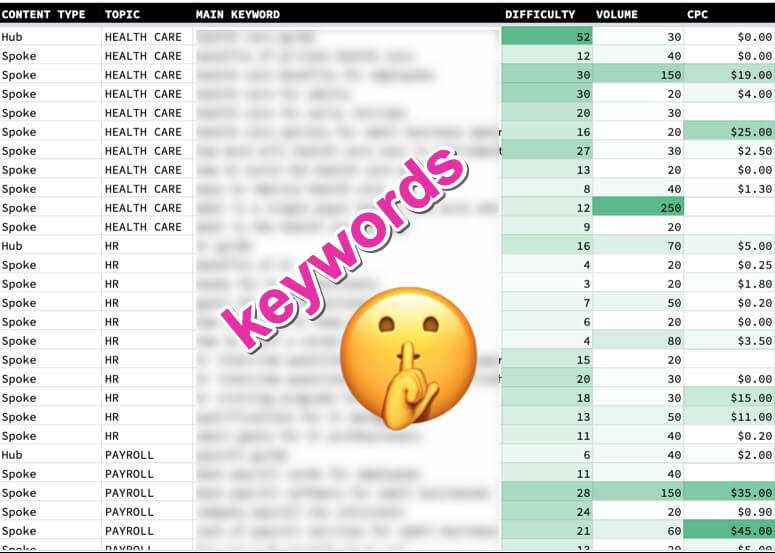
It’s important to keep a permanent list for several reasons. Creating a keyword research list gives you:
- A lasting record of what you’ve targeted
- A starting point for further development
- A resource that you can pass off to other team members
It should include all of the terms that you’re using, including a variety that is fit for different customers or different stages of the buying process. In most cases, that’s going to mean a healthy selection of:
- question keywords
- buyer intent keywords
- long-tail keywords
SEO keywords vs. PPC keywords
It’s important to understand the difference between SEO keywords and PPC keywords.
The main difference is intent.
SEO keyword lists are broad and fit to be used for long-term strategies. They may change a lot over time because there is a lot of room for testing and error.
PPC keyword lists, on the other hand, focus on a tight set of keywords that target buyers at the end of the buying process. They are designed to be cost-effective for the budget of the project. That may mean that high-competition keywords won’t even make the cut.
Now that you know what SEO keyword lists are, and how they’re different from PPC lists, let’s focus on what it means to develop SEO keywords effectively.
5 Tips for Creating a Keyword List
There are a lot of theories on how to develop great lists. Our theory comes down to 5 practices that have made it possible for us to build powerful, growth-oriented lists.
These practices are easy to implement if you already understand the fundamentals of keyword research and keyword metrics.
Here are 5 tips that will help you learn how to create a keyword list for SEO.
1) Create a list of high-level topics (or seed keywords)
A great list starts with as much potential as possible.
The best place to begin is with seed keywords that can point you toward a world of other possibilities. These types of keywords are the foundation of your research and enable all of the next steps.
What is a seed keyword?
Your seed keywords are the terms that capture high-level topics. Think big topics like “weight loss,” or “camping.”
You can find these terms in many different keyword tools.
In Ahrefs, they are called “parent keywords”. A parent keyword section will come up for any search you perform. Below, you can see what comes up when you search for weight loss.
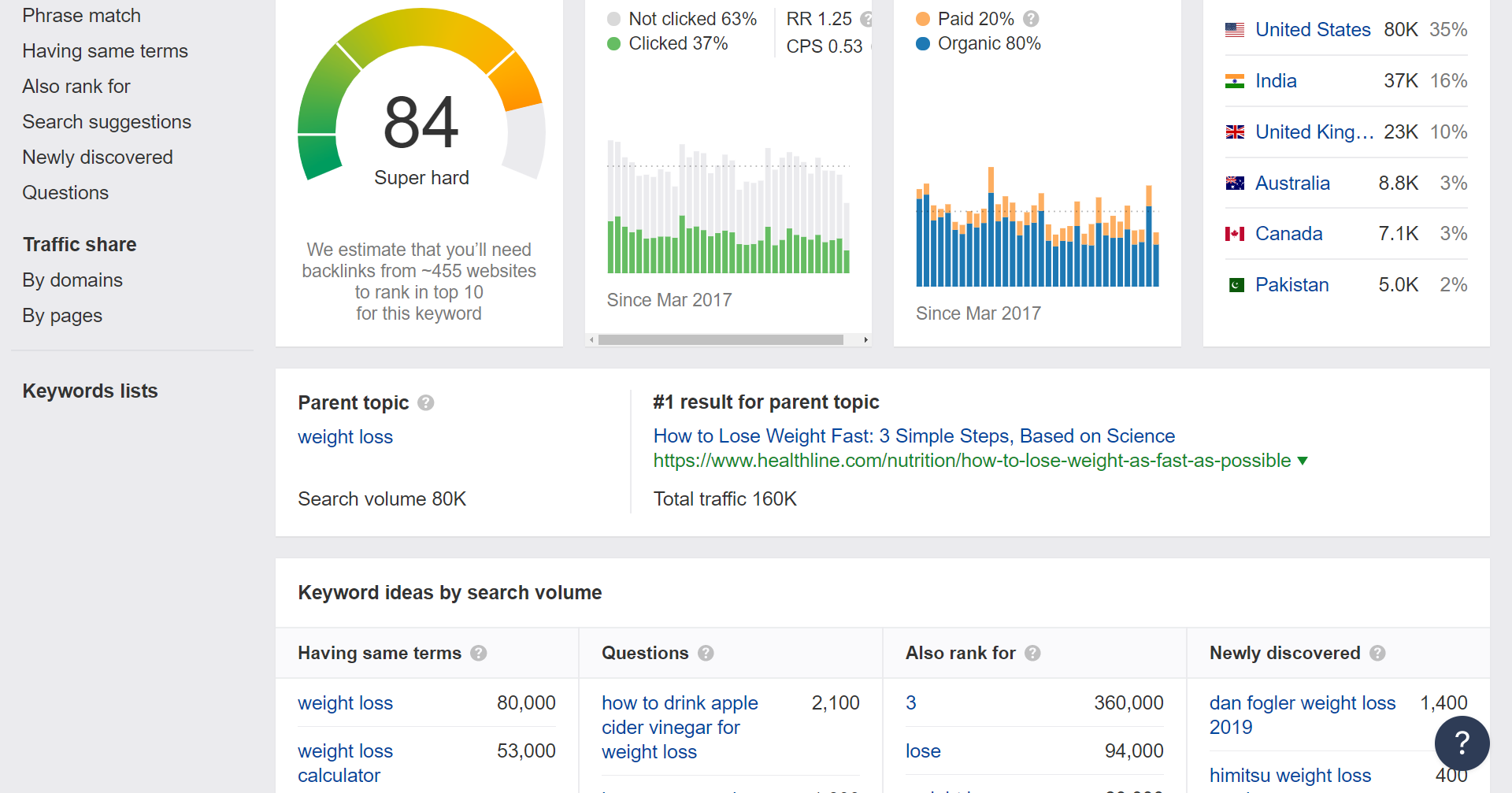
High-level terms don’t have much focus on their own.
However, they do help point you toward terms that do. Sticking with Ahrefs, let’s look at what kind of related terms come up with a one-click search for “weight loss” in the keyword tool:
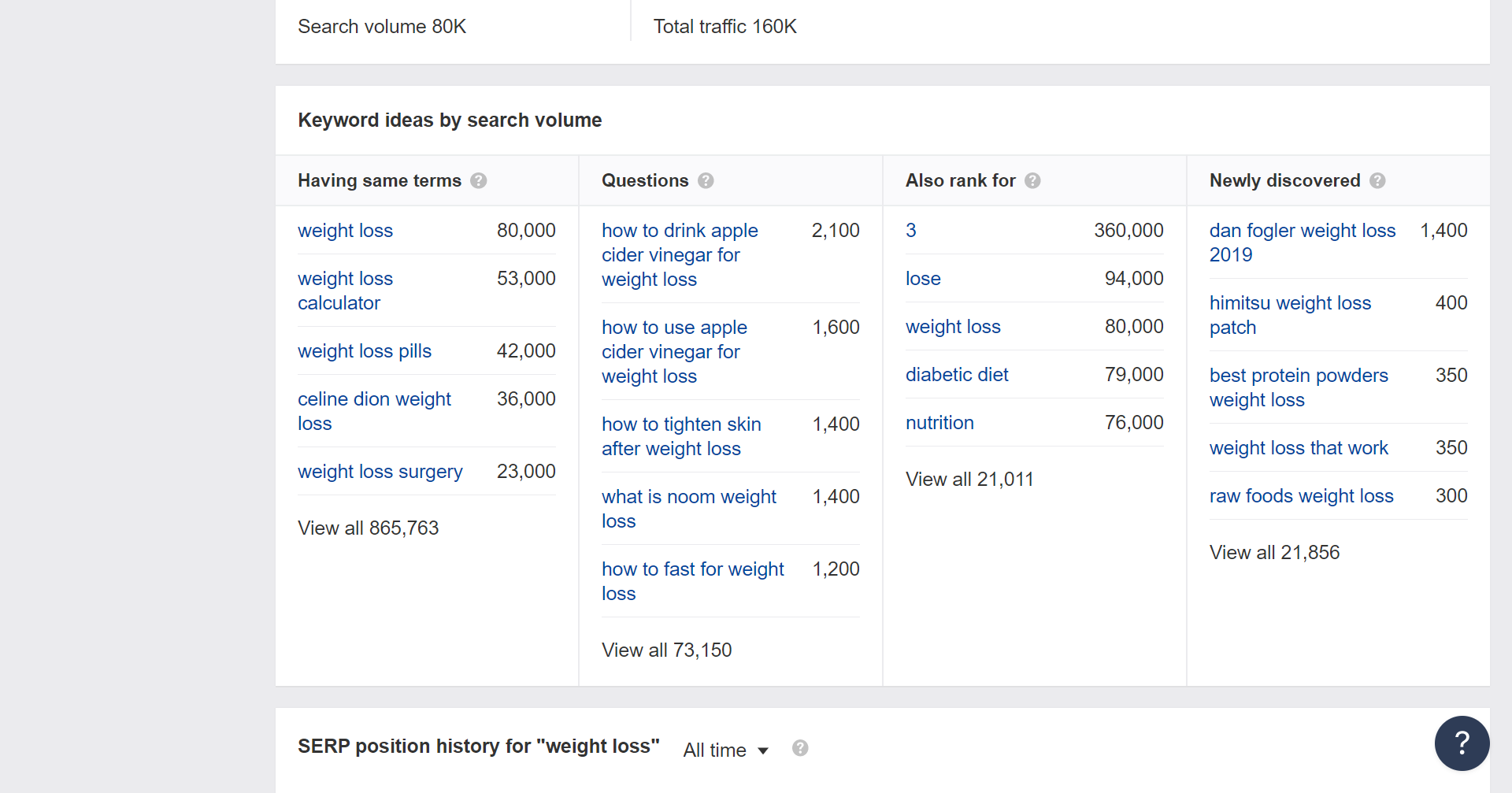
Here, we see a list of terms that are related to weight loss. As you can see, there are tens of thousands of terms available for this topic, including long-tail keywords and questions.
Uncover new keywords 🔑
Give us some topics/seed keywords and we’ll research these queries, along with related terms, search intent and topic grouping. Then we’ll compile into an actionable keyword report.
Let’s look at how you filter this massive list into just the keywords you need.
2) Filter by relevance (aka focus your list)
Now, you have thousands of potential keywords to choose from:

However, you can’t do much with that amount of keyword data. Your next step should be to start filtering the keywords down by relevance.
Relevance is important to both your business and SEO goals because only the right keywords will draw in the traffic that’s ready to perform the actions you want. This concept is known as ‘searcher intent’.
Searcher intent is a measure of what the search terms communicate about what the searcher wants.
Here are some additional ways that you can drill down to more relevant keywords depending on your circumstances:
- Small Town (Choose Broad Keywords): If you’re targeting a small town, there is likely to be a limited number of each type of service. That means you have some freedom here to choose high-level keywords and still get some good traffic.
- Large City (Choose Specific Keywords): In larger cities, there is stiffer competition for different services. Also, a city economy can sustain more niche types of services. For that reason, it’s practical to target specific keywords with longer tails. There is likely to be distinct traffic for different paths to “weight loss”, such as “weight loss exercise programs” or “weight loss clinics”.
- National (Choose Specific Keywords + Competitive Research): National targeting requires specific keywords along with intense competitor research. More terms will be in play at this level, because of the different ways people describe the same products. If you want to know what’s most powerful, watch what they’re doing.
- Exclude irrelevant terms: It should go without saying that you need to purge irrelevant terms from your keyword lists. Any terms that you aren’t going to pursue should be removed so that the list can be safely passed to others without confusing them.
- Exclude brand terms: Unless the brand is yours, branded terms should be avoided. If you’re in a niche with a powerful brand, you may have success with terms like “alternatives to…”.
3) Get (useful) keyword data
When you’ve filtered your list down to some of the best fits for your project, you need to start collecting data about those keywords using your tool of choice.
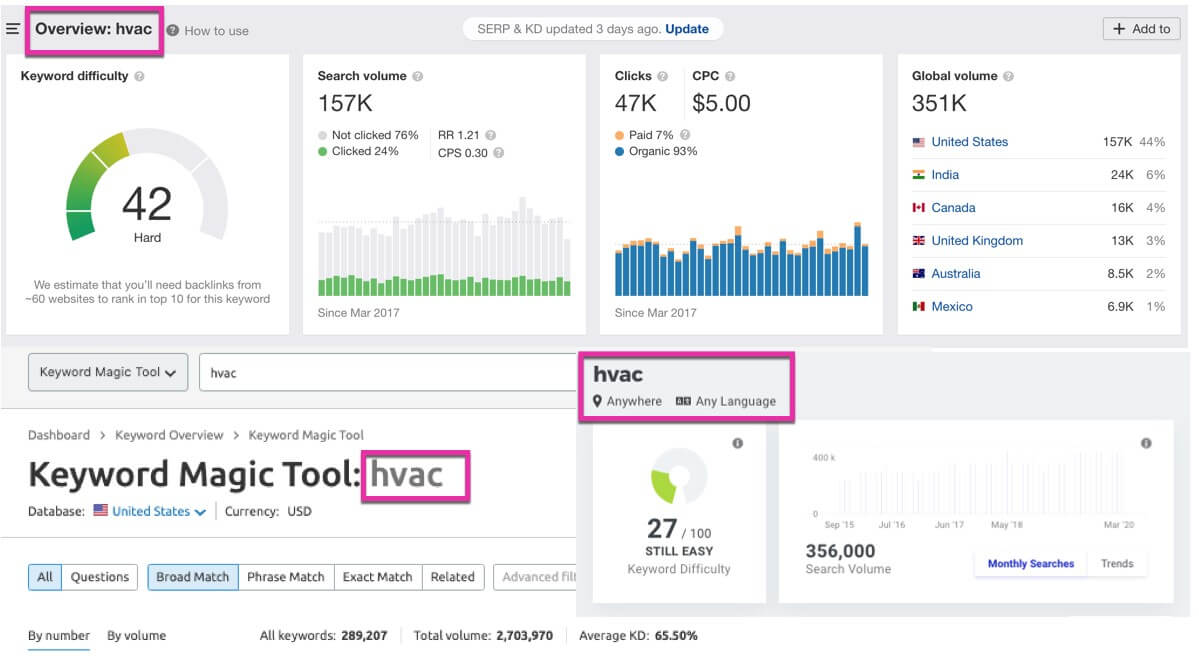
This data is known as keyword metrics. There is a lot of data available in most keyword tools that can be helpful for this step:
- Search volume: This is a measure of often the term is searched. Terms with a low search volume aren’t likely to be valuable because no one is searching for them.
- Trends: This is a measure of how the search volume has changed over time. For example, the term may be growing in use, or declining.
- Difficulty: This is a measure of how hard it is to rank for a keyword, based on whether the top spots experience much movement. Many keyword tools have their own way of measuring this.
- CPC (Cost-per-click): This is a measure of the cost to display an ad for a given keyword. A high cost means that there are a lot of people competing for the term. This usually means high intentionality.
- SERP features: This is a measure of what kinds of SERP features show up for a given search. For certain searches, organic search results will appear far lower than features like the snack pack or Q&As. It may be more worthwhile to target the features rather than the top spot.
There are other metrics you can use, and some metrics are unique to certain tools.
For example, Ahrefs has a feature called CPS (clicks-per-search). This is a measure of how often searches end in clicks:
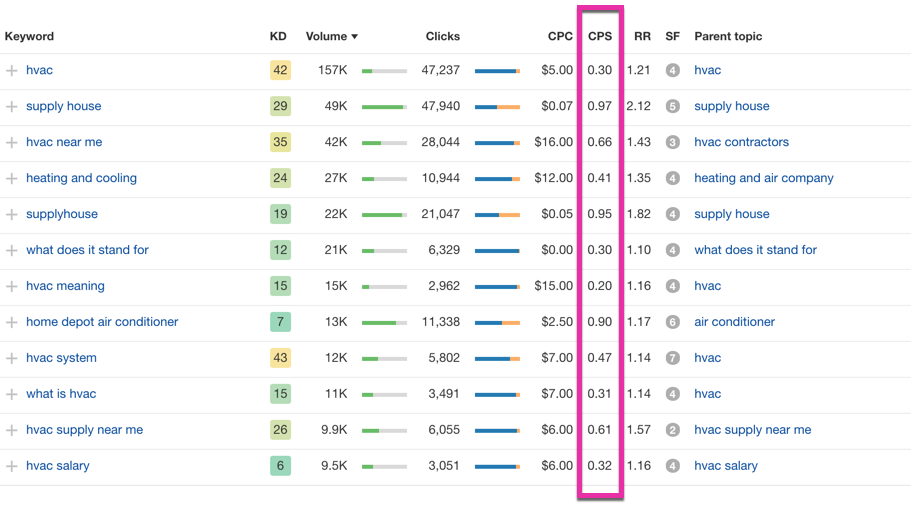
A low CPS can mean that people are finding the information they want on the SERPs page and don’t need or want to click further. This is because some SERP features directly answer the question.
4) See what your competitors are doing
Competitor research isn’t just effective; it can save you a significant amount of money (and time).
Many keyword tools allow you to perform competitor keyword analysis to tell you what terms a website is targeting.
Combine that with some spreadsheet magic and you’ve got a nice litter overview of your keyword gaps:
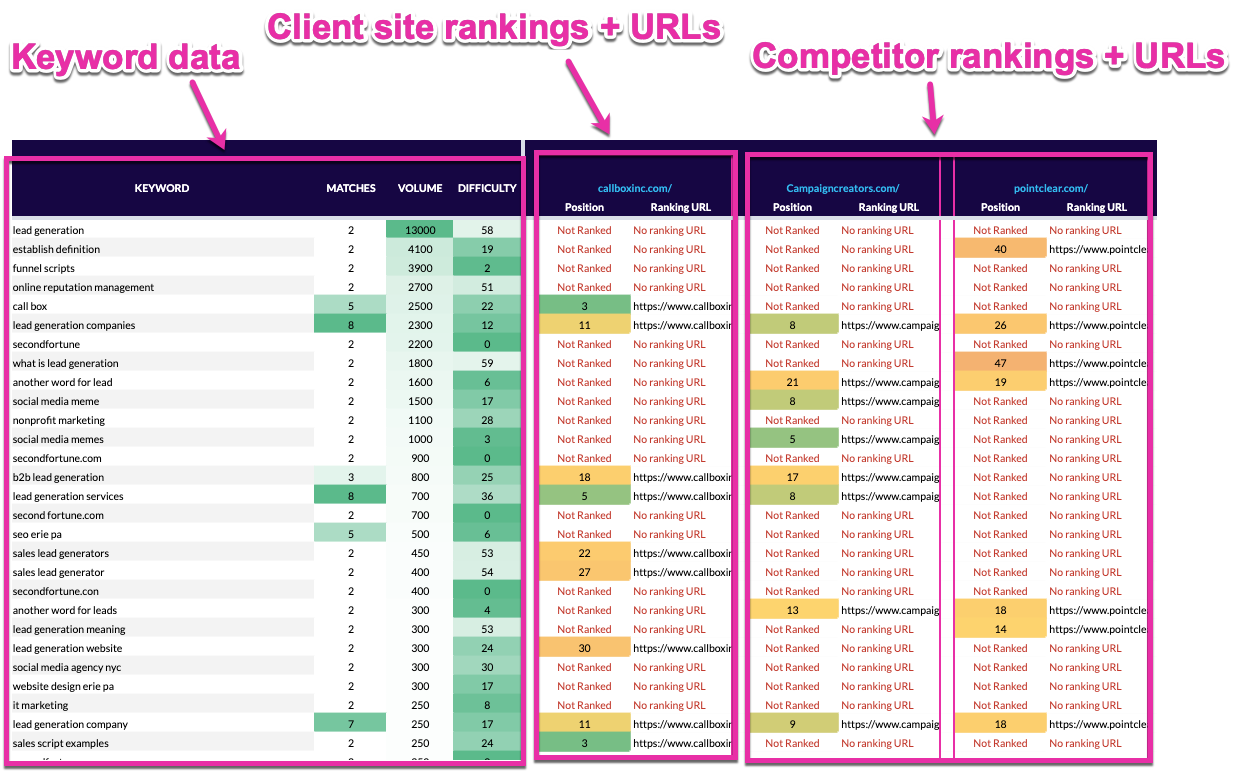
This is a very effective way to get ahead.
If your competitor is well-established in the niche, the keywords they are targeting may be the result of years of testing and trial. By learning from your competitors, you can skip that work and jump to where they are.
You can also use what you learn from their lists to grow your own.
By researching a set of competitors, you can develop a large list of what terms are being used across your niche. Remember to keep the domains you research in mind. You can use them for link building down the line.
5) Put it all together & map to URLs
Once you have a list of keywords you feel confident about, you’re ready to start putting your sheet together and mapping your keywords out to different pages.
You don’t need to reinvent the wheel here. Just a simple spreadsheet that lets you map pages >>> keywords.
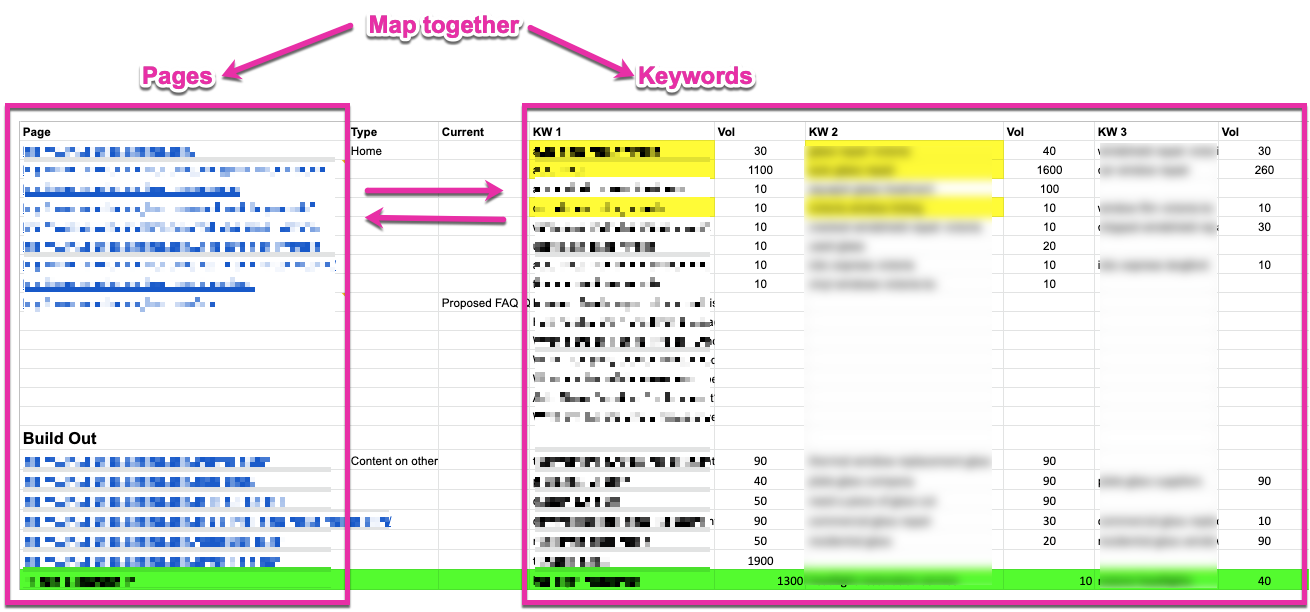
Why bother doing this?
The structure of your site, and the way it organizes information are an important part of SEO.

Well-structured websites group related information together by topic or theme. Single pages should stick to one topic, and be closely linked to pages that have related information. Unrelated topics need to be kept separate.
This is called siloing.
Source: https://www.bruceclay.com/seo/silo/
Siloing can make your pages more relevant for their given topic. It can improve their performance in SERPs. Normally, it’s hard to do, but when you have an SEO keyword list ready, it can make the work much easier.
Use the keyword list to define all of the topics that will be covered. Separate the information into sets of pages that will be linked together, and map keywords to the most appropriate ones.
It’s worth it to go through the work of making your list clean and logically laid-out. Remember, this list is more useful when you can easily pass it off to other team members, outside agencies and shareholders.
Once you have the structure in place, you have something that you can revisit at the end of SEO campaigns to constantly improve on in the future.
Get Building Your SEO Keyword List
Now, you understand some of the finer points of developing SEO keyword lists.
Just start with good seeds, cut out the fat, follow the patterns to get useful data, and keep one eye on what your competitors are doing. After that, all you need to do is put it all together and map to URLs.
While what you’ve learned here will get you started, it only touches the surface of what it means to perform effective keyword research.
You can go much deeper down the keyword research rabbit hole.
Hand off the toughest tasks in SEO, PPC, and content without compromising quality
Explore ServicesWritten by Aaron Haynes on April 30, 2020
CEO and partner at Loganix, I believe in taking what you do best and sharing it with the world in the most transparent and powerful way possible. If I am not running the business, I am neck deep in client SEO.





